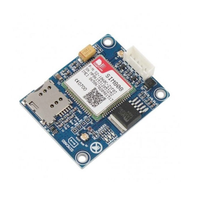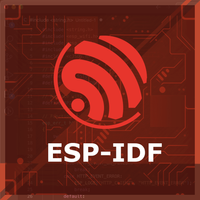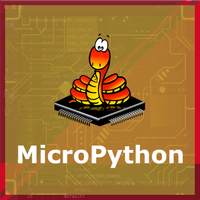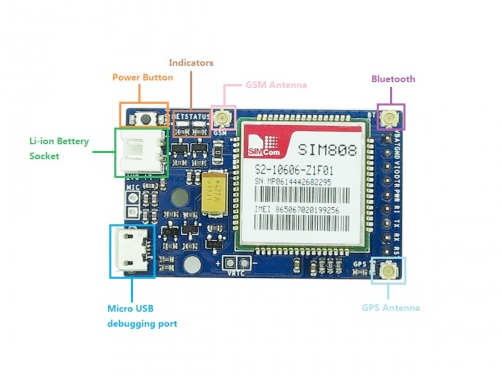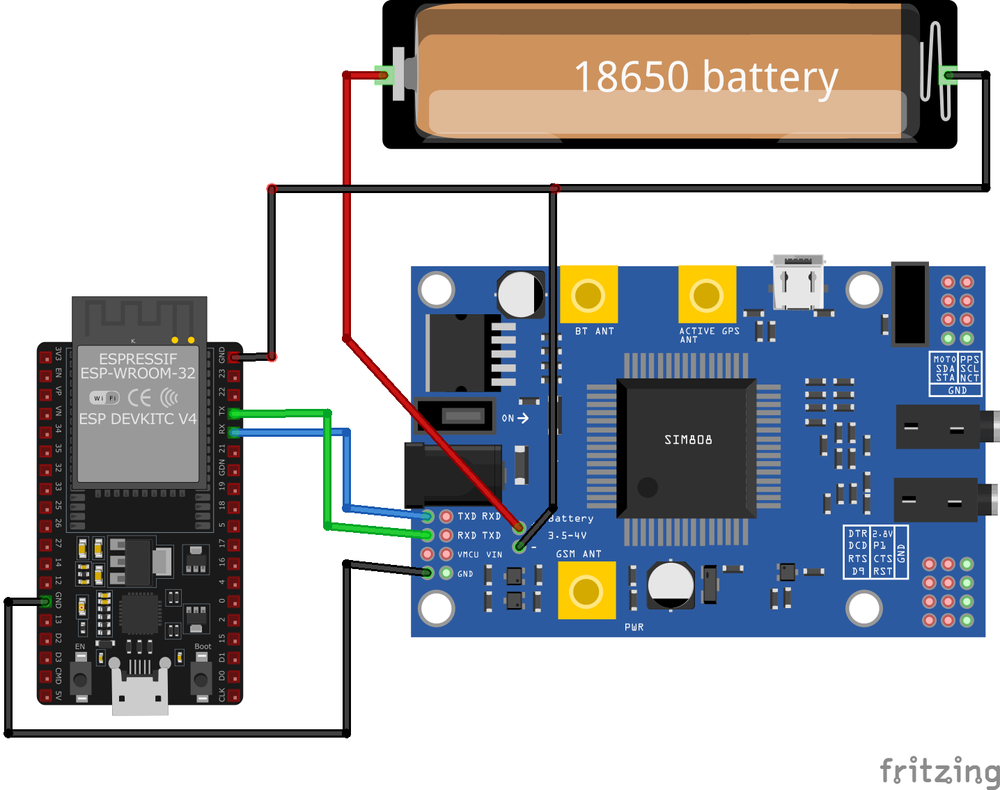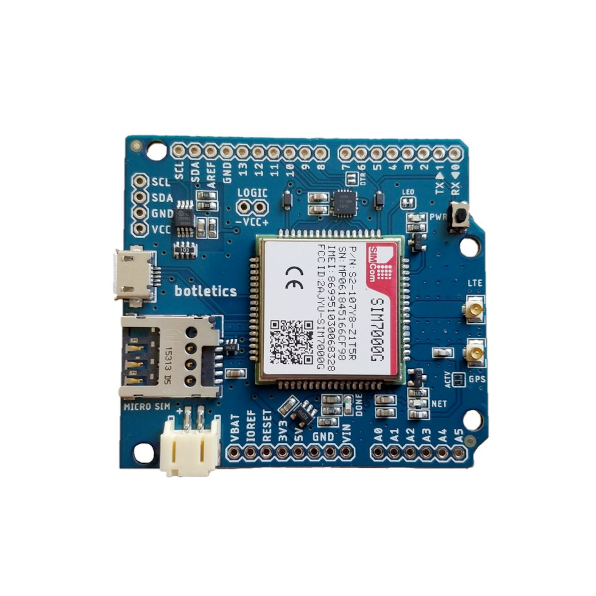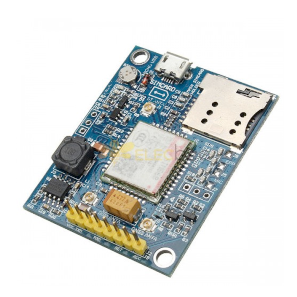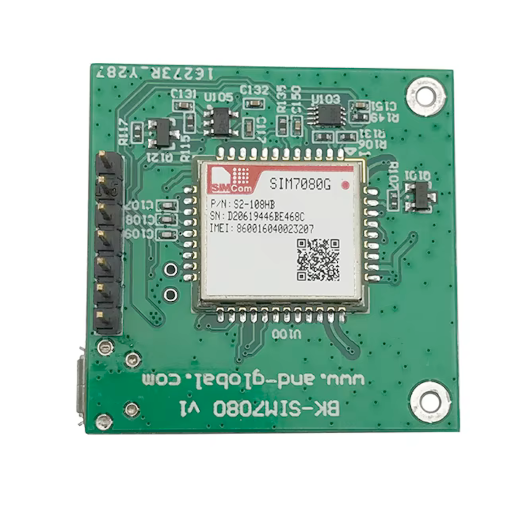ESP32 SIM808 GSM/GPRS + GPS Module Pinout, Wiring, ESP32 and more
Overview
The SIM808 is a versatile GSM/GPRS module with integrated GPS functionality, providing quad-band connectivity for voice, SMS, data, and satellite navigation applications. Its compact design and multiple interfaces make it suitable for a wide range of communication and tracking projects.
About SIM808 GSM/GPRS + GPS Module
The SIM808 is a quad-band GSM/GPRS module with integrated GPS, making it ideal for vehicle tracking, wearable devices, and industrial automation. It supports voice, SMS, GPRS data, and satellite navigation, offering a complete communication solution for IoT applications.
⚡ Key Features
- Quad-Band GSM (850/900/1800/1900MHz) – Ensures global cellular network support.
- Integrated GPS – Enables real-time location tracking and navigation.
- Versatile Communication – Supports voice calls, SMS, and GPRS data transfer.
- Multiple Interfaces – Includes UART, USB, and GPIO for flexible connectivity.
🔗 Still deciding on a SIM module? Check the ESP32 SIM Modules Comparison Table for a breakdown of LTE, 3G, and GPRS options.
Where to Buy SIM808 GSM/GPRS + GPS Module



Prices are subject to change. We earn from qualifying purchases as an Amazon Associate.
SIM808 Datasheet and Technical Specifications
SIM808 Pinout Diagram
The VCC pin is used to supply power to the sensor,
and it typically requires 3.3V or 5V (refer to the datasheet for specific voltage requirements).
The GND pin is the ground connection and must be
connected to the ground of your ESP32.
The SIM808 pinout includes:
- VBAT: Power supply input (3.4V to 4.4V).
- GND: Ground connection.
- TXD: UART Transmit Data (connects to microcontroller RX).
- RXD: UART Receive Data (connects to microcontroller TX).
- PWRKEY: Power on/off control (active low).
- NETLIGHT: Network status indication.
- STATUS: Module operating status indication.
- GPS_VCC: GPS power supply.
- GPS_TX: GPS UART Transmit Data.
- GPS_RX: GPS UART Receive Data.
- SIM_VDD: SIM card power supply.
- SIM_DATA: SIM card data I/O.
- SIM_CLK: SIM card clock.
- SIM_RST: SIM card reset.
SIM808 Wiring with ESP32
- Connect
VBATto a stable power supply within the range of 3.4V to 4.4V. - Connect
GNDto the ground of the microcontroller. - Connect
TXDto the RX pin of the microcontroller andRXDto the TX pin. - Connect
PWRKEYto a GPIO pin on the microcontroller; to power on the module, pull this pin low for at least 1 second. - Optionally, connect
NETLIGHTandSTATUSpins to LEDs for network and status indications. - For GPS functionality, connect
GPS_VCCto a 3.3V power supply, andGPS_TXandGPS_RXto the microcontroller's UART pins if separate from the GSM UART. - For SIM card connections, connect
SIM_VDD,SIM_DATA,SIM_CLK, andSIM_RSTto the corresponding pins on the SIM card holder.
SIM808 Troubleshooting Guide
Common Issues
🔌 Module Fails to Power On
Issue: The SIM808 module does not power up or respond to commands.
Possible causes include insufficient power supply, incorrect wiring, or faulty hardware.
Solution: Ensure the module is connected to a stable power source within the recommended voltage range of 3.4V to 4.4V. Verify that all connections are secure and correctly configured. If the problem persists, consider testing the module with a different power source or replacing it.
📶 SIM Card Not Recognized
Issue: The module fails to detect or register the SIM card.
Possible causes include improper SIM card insertion, unsupported SIM card type, or SIM card lock.
Solution: Ensure the SIM card is properly inserted into the module's SIM card slot and is compatible with the GSM network. Verify that the SIM card is active and unlocked. If necessary, test the SIM card in another device to confirm its functionality.
📡 Poor Network Signal or Connectivity Issues
Issue: The module experiences weak signal strength or fails to maintain a stable network connection.
Possible causes include improper antenna connection, environmental interference, or network coverage limitations.
Solution: Ensure the GSM antenna is securely connected to the module and positioned for optimal signal reception. Avoid placing the module near sources of electromagnetic interference. Check the network coverage in your area to ensure adequate signal strength.
⌨️ AT Commands Not Responding
Issue: The module does not respond to AT commands sent from the microcontroller or computer.
Possible causes include incorrect baud rate settings, faulty serial connections, or improper command syntax.
Solution: Verify that the baud rate of the module matches that of the microcontroller or computer; the default baud rate is 9600 bps. Check that the TX and RX lines are correctly connected and that there are no loose connections. Ensure that AT commands are correctly formatted and terminated with a carriage return.
🛰️ GPS Functionality Not Working
Issue: The SIM808 module fails to acquire GPS signals or provide location data.
Possible causes include improper antenna connection, obstructed view of the sky, or GPS functionality not enabled.
Solution: Ensure the GPS antenna is properly connected and has a clear view of the sky to receive satellite signals. Verify that the GPS functionality is enabled by sending the appropriate AT commands to power on the GPS engine.
Debugging Tips
🔍 Serial Monitor
Use the Serial Monitor to check for error messages and verify the sensor's output. Add debug prints in your code to track the sensor's state.
⚡ Voltage Checks
Use a multimeter to verify voltage levels and check for continuity in your connections. Ensure the power supply is stable and within the sensor's requirements.
Additional Resources
SIM808 Code Examples
Arduino Example
#include <Arduino.h>
// Define ESP32 hardware serial port for SIM808
#define SIM808_TX 17 // ESP32 TX connected to SIM808 RX
#define SIM808_RX 16 // ESP32 RX connected to SIM808 TX
#define PWRKEY 9 // SIM808 Power Key pin (adjust if needed)
// Initialize hardware serial for SIM808
HardwareSerial sim808(2);
void powerOnSIM808() {
pinMode(PWRKEY, OUTPUT);
digitalWrite(PWRKEY, LOW);
delay(1000); // PWRKEY must be held LOW for at least 1 second
digitalWrite(PWRKEY, HIGH);
delay(5000); // Wait for the module to initialize
}
void setup() {
Serial.begin(115200); // Serial Monitor
sim808.begin(9600, SERIAL_8N1, SIM808_RX, SIM808_TX); // SIM808 UART
powerOnSIM808();
Serial.println("Testing AT communication...");
// Test AT command
sendATCommand("AT");
// Set SMS text mode
sendATCommand("AT+CMGF=1");
// Send SMS
Serial.println("Sending SMS...");
sim808.println("AT+CMGS="+1234567890""); // Replace with recipient's number
delay(1000);
sim808.print("Hello from ESP32 and SIM808");
sim808.write(26); // CTRL+Z to send
delay(5000);
printResponse();
}
void loop() {
// Add code to handle incoming messages or other functionalities
}
// Function to send an AT command and print response
void sendATCommand(const char *command) {
Serial.print("Sending: ");
Serial.println(command);
sim808.println(command);
delay(1000);
printResponse();
}
// Function to print response from SIM808
void printResponse() {
while (sim808.available()) {
Serial.write(sim808.read());
}
Serial.println("
----------------------
");
}This Arduino sketch interfaces with the SIM808 module using ESP32's hardware serial (UART2) for reliable communication.
Key Features #
- Hardware Serial (UART2) is used instead of SoftwareSerial.
- PWRKEY (GPIO9) powers on the SIM808 module.
- AT Commands test communication (
AT), enable SMS mode (AT+CMGF=1), and send an SMS (AT+CMGS). - GPS functionality can be added if needed.
Connections #
- ESP32 TX (GPIO17) → SIM808 RX
- ESP32 RX (GPIO16) → SIM808 TX
- Baud rate: 9600
Why Hardware Serial? #
- More stable and faster than SoftwareSerial.
- Dedicated UART2 prevents conflicts with Serial Monitor.
This setup allows SMS sending and further expansion for GPS or network functionalities. 🚀
ESP-IDF Example
#include <stdio.h>
#include <string.h>
#include "driver/uart.h"
#include "driver/gpio.h"
#include "freertos/task.h"
#define TX_PIN 17
#define RX_PIN 16
#define PWRKEY_PIN 4
#define UART_PORT UART_NUM_1
#define GPS_UART_PORT UART_NUM_2
void init_uart() {
uart_config_t uart_config = {
.baud_rate = 9600,
.data_bits = UART_DATA_8_BITS,
.parity = UART_PARITY_DISABLE,
.stop_bits = UART_STOP_BITS_1,
.flow_ctrl = UART_HW_FLOWCTRL_DISABLE
};
uart_param_config(UART_PORT, &uart_config);
uart_set_pin(UART_PORT, TX_PIN, RX_PIN, UART_PIN_NO_CHANGE, UART_PIN_NO_CHANGE);
uart_driver_install(UART_PORT, 1024, 0, 0, NULL, 0);
}
void power_on_sim808() {
gpio_set_direction(PWRKEY_PIN, GPIO_MODE_OUTPUT);
gpio_set_level(PWRKEY_PIN, 0);
vTaskDelay(1000 / portTICK_PERIOD_MS); // Hold PWRKEY low for 1 second
gpio_set_level(PWRKEY_PIN, 1);
vTaskDelay(5000 / portTICK_PERIOD_MS); // Wait for the module to initialize
}
void app_main(void) {
init_uart();
power_on_sim808();
char *test_cmd = "AT\r\n";
uart_write_bytes(UART_PORT, test_cmd, strlen(test_cmd));
while (true) {
char data[128];
int len = uart_read_bytes(UART_PORT, data, sizeof(data), 100 / portTICK_PERIOD_MS);
if (len > 0) {
data[len] = '\0';
printf("Response: %s\n", data);
}
vTaskDelay(1000 / portTICK_PERIOD_MS);
}
}ESPHome Example
uart:
tx_pin: GPIO17
rx_pin: GPIO16
baud_rate: 9600
switch:
- platform: gpio
name: "SIM808 Power"
pin:
number: GPIO4
inverted: true
switch:
- platform: template
name: "Send AT Command"
turn_on_action:
- uart.write: "AT\r\n"
sensor:
- platform: custom
lambda: |-
return {nullptr};
sensors:
- name: "SIM808 Response"PlatformIO Example
platformio.ini
[env:sim808]
platform = espressif32
board = esp32dev
framework = arduino
monitor_speed = 115200PlatformIO Example Code
#include <HardwareSerial.h>
#include <Arduino.h>
HardwareSerial sim808(1);
#define PWRKEY 4
void power_on_sim808() {
pinMode(PWRKEY, OUTPUT);
digitalWrite(PWRKEY, LOW);
delay(1000); // Hold PWRKEY low for 1 second
digitalWrite(PWRKEY, HIGH);
delay(5000); // Wait for initialization
}
void setup() {
Serial.begin(115200);
sim808.begin(9600, SERIAL_8N1, 16, 17); // RX, TX
power_on_sim808();
// Test AT command
sim808.println("AT");
delay(1000);
while (sim808.available()) {
Serial.write(sim808.read());
}
}
void loop() {
sim808.println("AT+CMGF=1"); // Set SMS to text mode
delay(1000);
sim808.println("AT+CMGS="+1234567890""); // Replace with recipient's number
delay(1000);
sim808.print("Hello from PlatformIO");
delay(1000);
sim808.write(26); // CTRL+Z to send SMS
delay(5000);
}power_on_sim808 function toggles the PWRKEY pin (GPIO4) to activate the module. The AT command is sent to test communication, and SMS functionality is implemented in the loop. GPIO16 (RX) and GPIO17 (TX) are configured as serial pins.
MicroPython Example
from machine import UART, Pin
import time
# Initialize UART
uart = UART(2, baudrate=9600, tx=17, rx=16)
pwrkey = Pin(4, Pin.OUT)
def power_on_sim808():
pwrkey.value(0)
time.sleep(1) # Hold PWRKEY low for 1 second
pwrkey.value(1)
time.sleep(5) # Wait for module to initialize
def send_at(command):
uart.write(command + '\r\n')
time.sleep(1)
while uart.any():
print(uart.read().decode('utf-8'), end='')
# Power on the module
power_on_sim808()
# Test communication
send_at('AT')
# Send SMS
send_at('AT+CMGF=1') # Set SMS to text mode
send_at('AT+CMGS="+1234567890"') # Replace with recipient's number
uart.write("Hello from MicroPython" + chr(26))power_on_sim808 function activates the module using the PWRKEY pin (GPIO4). The send_at function sends AT commands and prints the responses. The script initializes the module, tests communication, and sends an SMS with a specified message. Additional logic can be added to read GPS data through UART.
Conclusion
The ESP32 SIM808 GSM/GPRS + GPS Module is a powerful SIM sensor that offers excellent performance and reliability. With support for multiple development platforms including Arduino, ESP-IDF, ESPHome, PlatformIO, and MicroPython, it's a versatile choice for your IoT projects.
For optimal performance, ensure proper wiring and follow the recommended configuration for your chosen development platform.
Always verify power supply requirements and pin connections before powering up your project to avoid potential damage.
